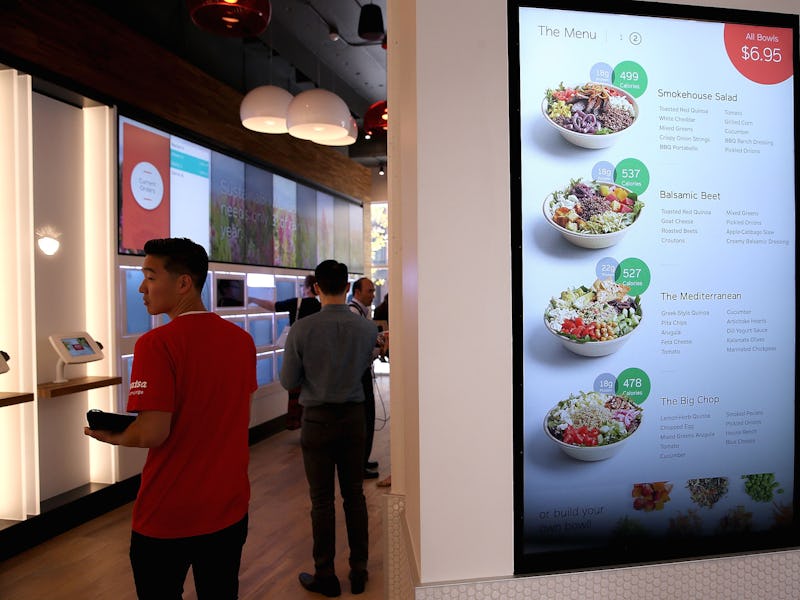If Eatsa Is the Future of Fast Food, It's a Dystopian Y.A. Nightmare
Automated eating is a lonely world.

Sometimes, near the day of reaping, father will spend long too long with the Drink of Sorrow and speak of the long long ago, and how in idle moments people would speak to each other in places that had “am-bee-anse” and how these stolen hours were valued for their exchange of ideas. But that was the before time, before the Syndicate, and I am but a simple girl who knows naught but the territory’s wheat harvesting mill, and could not possibly make a difference.
So might run the inner monologue of future diners, who have no one else to talk to as Eatsa’s spread their brand of self-service eateries across the land.
Opening Monday in San Francisco with a vegetarian menu based entirely around grain crop quinoa, Eatsa’s goal is to provide efficient, automated service with sustainable, healthy food. Business Insider reports that workers’ salaries make up roughly 30 percent of the operating costs. Early reviews, bathed in the sanguine glow of the new, have been uniformly enthusiastic.
But doesn’t this ignore decades of restaurant science? Studies have reliably shown that details like lighting, service, and presentation can keep customers coming back for longer stays. Happy people love spending money on food, but in fickle fashion. Even the weight of your cutlery can affect how you gauge a meal’s quality.
Inverse’s own CEO Dave Nemetz led a street team of staff to the location, just blocks away from the site’s San Francisco offices. Relaying the experience in real-time via Slack messaging, Dave called it the “restaurant version of clickbait.”
“It’s weird,” he reported. “You order from a screen. Then wait in front of a wall of cubby holes that your food appears in. They have everyone’s name on the board and you wait for yours to get highlighted with your cubby hole number. Like waiting for your number at the DMV.” A more flattering comparison, I’m sure you could imagine.
Later, once the man who signs my checks had been delivered his burrito bowl with an unwanted cup of fruit, he could only express disappointment bordering on confusion over the whole operation.
“The food isnt great,” he wrote me. “My burrito bowl was OK. For all we know it’s just a typical Chipotle-like kitchen back there with low-paid workers prepping bowls and then pushing them out through the cubbies. I guess they offer customization and will (soon) have an app that you can order ahead with. But Chipotle already has both, plus meat.
“But to be clear,” he summed up, “we won’t be back.”
Fellow diner and Inverse CTO Winton Welsh was similarly unimpressed, saying that Eatsa was “taking the worst parts of the restaurant experience and amplifying them.”
Co-founder and product/design lead Steve Marshall was sickened to his core to such a degree he was unable to communicate using the language centers of the brain, and was reduced to communicating with a gif of a sweat-streaked Kyle MacLachlan howling “DISAPPOINTMENT.”
And while Steve and Winton’s palates were tempered in the provincial planes of Indiana and Texas, respectively, Dave is a self-described New Age Californian and therefor probably has his picture in the Eatsa marketing materials under the heading “targeted consumers.”
Dave’s description, of a sterile government building and hit-and-miss automation that may only be an excuse to spare you the site of the poor people preparing your bowl, is a dark vision indeed. Little more than a series of tubes rewarding the maze hamsters for retaining just enough energy to fly themselves against the feed button before they turn back to their endless, lonely labor in service of unknowable forces. At least at Chipotle there’s room to sit.
Well, it certainly feels that way when you walk through the doors at the flagship location of Eatsa, a new high-tech fast food restaurant that opens today, Monday, August 31st, near San Francisco’s Embarcadero.